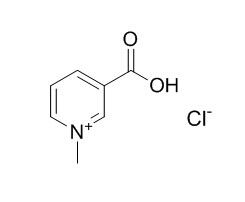Trigonelline hydrochloride
Trigonelline chloride, an alkaloid with potential antidiabetic activity, is present in considerable amounts in coffee. Trigonelline hydrochloride reduces diabetic auditory neuropathy by affecting β cell regeneration.
Inquire / Order:
manager@chemfaces.com
Technical Inquiries:
service@chemfaces.com
Tel:
+86-27-84237783
Fax:
+86-27-84254680
Address:
1 Building, No. 83, CheCheng Rd., Wuhan Economic and Technological Development Zone, Wuhan, Hubei 430056, PRC
Providing storage is as stated on the product vial and the vial is kept tightly sealed, the product can be stored for up to
24 months(2-8C).
Wherever possible, you should prepare and use solutions on the same day. However, if you need to make up stock solutions in advance, we recommend that you store the solution as aliquots in tightly sealed vials at -20C. Generally, these will be useable for up to two weeks. Before use, and prior to opening the vial we recommend that you allow your product to equilibrate to room temperature for at least 1 hour.
Need more advice on solubility, usage and handling? Please email to: service@chemfaces.com
The packaging of the product may have turned upside down during transportation, resulting in the natural compounds adhering to the neck or cap of the vial. take the vial out of its packaging and gently shake to let the compounds fall to the bottom of the vial. for liquid products, centrifuge at 200-500 RPM to gather the liquid at the bottom of the vial. try to avoid loss or contamination during handling.
Phytomedicine.2021, 2(82):153452
LWT2024, v208:116677
Separations2023, 10(11), 567;
Molecules.2017, 22(2)
Evid Based Complement Alternat Med.2021, 2021:5319584.
J.the Korean Socie. Food Sci.&Nut.2023; 52(1):26-39.
J of the Society of Cosmetic Scientists of Korea2018, 44(4):407-417
Phytother Res.2019, 33(3):676-689
Korean J Environ Agric.2018, 37(4):260-267
J Bone Miner Res.2017, 32(12):2415-2430
Related and Featured Products
J Agric Food Chem. 2003 Dec 17;51(26):7568-75.
Effects of coffee components on the response of GABA(A) receptors expressed in Xenopus oocytes.[Pubmed:
14664509]
METHODS AND RESULTS:
The effects of both coffee components and coffee extract on the electrical responses of GABA(A) receptors expressed in Xenopus oocytes were studied by injecting cRNAs of the alpha(1) and beta(1) subunits of the bovine receptors. The aqueous extract of coffee dose-dependently inhibited the GABA-elicited responses, whereas the lipophilic extract of coffee by diethyl ether slightly potentiated it at low doses (0.1-0.4 microL/mL) but showed inhibition at high doses (0.5-0.8 microL/mL). Theophylline inhibited the response in a noncompetitive mechanism (K(i) = 0.55 mM), whereas theobromine and Trigonelline hydrochloride inhibited it in a competitive manner, K(i) = 3.8 and 13 mM, respectively. Benzothiazole, catechol, 2,4-dimethylstyrene, guaiacol, 1-octen-3-ol, sotolone, and 2,3,5-trimethylphenol potentiated the responses significantly.
CONCLUSIONS:
Potentiation elicited by guaiacol and sotolone was independent of GABA concentrations, whereas that by 1-octen-3-ol was dependent. When 1-octen-3-ol (100 mg/kg) was orally administered to mice prior to intraperitoneal administration of pentobarbital, the sleeping time of mice induced by pentobarbital increased significantly.
Nihon Arukoru Yakubutsu Igakkai Zasshi. 2011 Apr;46(2):260-9.
Effect of coffee extracts on plasma fibrinolysis and platelet aggregation.[Pubmed:
21702337]
We have previously reported on study results showing that certain types of coffee have the activity to enhance fibrinolysis.
METHODS AND RESULTS:
This report covers the activity of 10 types of hot water extracts of coffee on human tissue-type plasminogen activator producing cells. Particularly strong activity (29-35 times the control amount) was observed for Blue Mountain, Yunnan and Kilimanjaro beans. It was found that the hot water extracts have anti-thrombin activity, and that coffee components have anti-platelet aggregation activity, although weak.
CONCLUSIONS:
It was revealed that there is no activity affecting tissue-type plasminogen activator producing cells in the coffee components chlorogenic acid, caffeine, quinic acid, Trigonelline hydrochloride, 5-(hydroxymethyl)-2-furfuryl and caffeic acid.
It was also revealed that there is activity in fractions with a molecular weight of 10,000 or less. This could also be inferred from the fact that oral administration of such fractions of coffee to human subjects resulted in a shortening of their plasma ELT (p<0.05).
J Agric Food Chem. 2002 Feb 27;50(5):1192-9.
Alkylpyridiniums. 1. Formation in model systems via thermal degradation of trigonelline.[Pubmed:
11853503]
Trigonelline is a well-known precursor of flavor/aroma compounds in coffee and undergoes significant degradation during roasting.
METHODS AND RESULTS:
This study investigates the major nonvolatile products that are procured after trigonelline has been subjected to mild pyrolysis conditions (220-250 degrees C) under atmospheric pressure. Various salt forms of trigonelline were also prepared and the thermally produced nonvolatiles analyzed by thin layer chromatography, liquid chromatography-electrospray ionization tandem mass spectrometry, and (1)H and (13)C nuclear magnetic resonance.
Results revealed the decarboxylated derivative 1-methylpyridinium as a major product of certain salts, the formation of which is positively correlated to temperature from 220 to 245 degrees C. Moreover, Trigonelline hydrochloride afforded far greater amounts of 1-methylpyridinium compared to the monohydrate over the temperature range studied.
CONCLUSIONS:
Investigations into other potential quaternary amine products of trigonelline also indicate nucleophilic substitution reactions that lead to dialkylpyridiniums, albeit at concentration levels approximately 100-fold lower than those recorded for 1-methylpyridinium.
Sensors (Basel). 2011;11(4):4030-42.
Surface plasmon resonance based biosensors for exploring the influence of alkaloids on aggregation of amyloid-β peptide.[Pubmed:
22163834]
METHODS AND RESULTS:
The main objective of the presented study was the development of a simple analytical tool for exploring the influence of naturally occurring compounds on the aggregation of amyloid-β peptide (Aβ(40)) in order to find potential anti-neurodegenerative drugs. The gold discs used for surface plasmon resonance (SPR) measurements were modified with thioaliphatic acid. The surface functionalized with carboxylic groups was used for covalent attaching of Aβ(40) probe by creation of amide bonds in the presence of EDC/NHS. The modified SPR gold discs were used for exploring the Aβ(40) aggregation process in the presence of selected alkaloids: arecoline hydrobromide, pseudopelletierine hydrochloride, Trigonelline hydrochloride and α-lobeline hydrochloride.
CONCLUSIONS:
The obtained results were discussed with other parameters which govern the phenomenon studied such as lipophilicity/hydrophilicy and Aβ(40)-alkaloid association constants.



